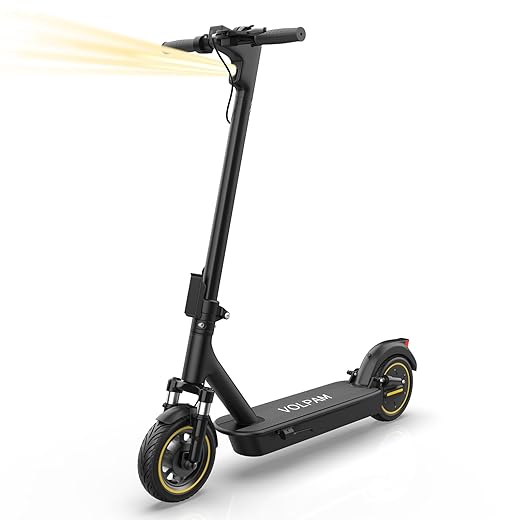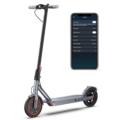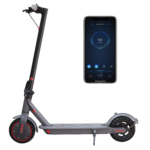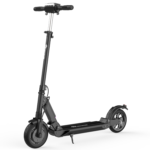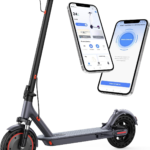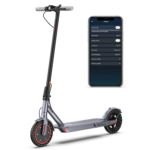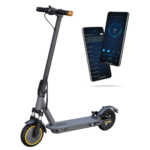- Home
- Scooters
- Electric Scooters
- VOLPAM SP01
VOLPAM SP01
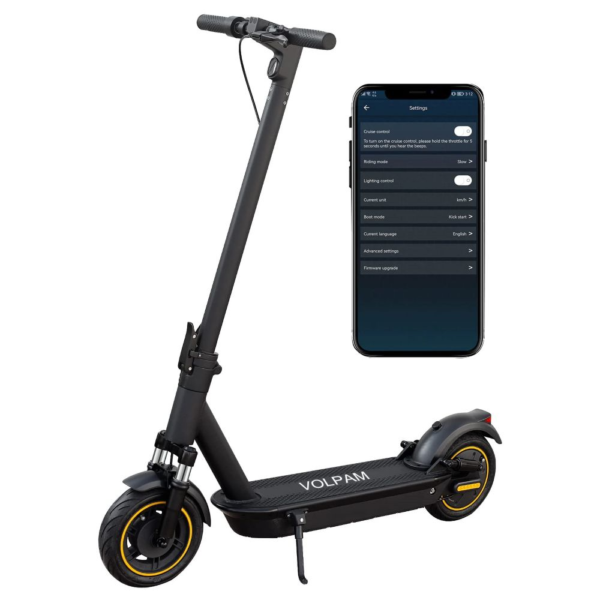


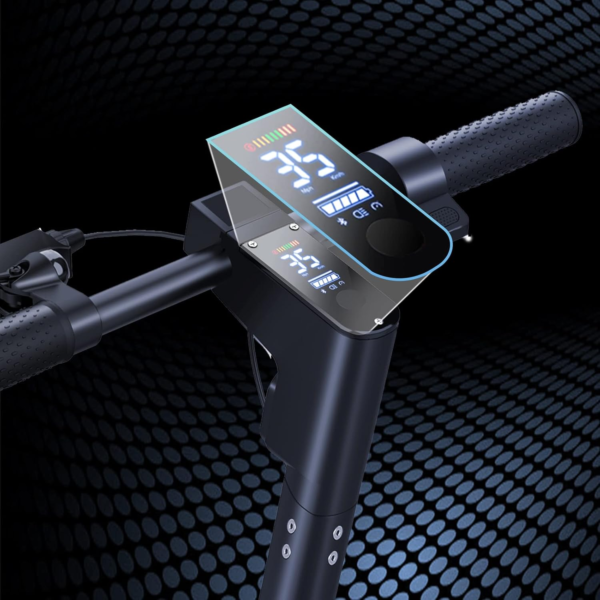
- Battery Range: 27 miles (43 km)
- Top Speed: 21 mph (34 km/h)
- Motor Power: 500 W
- Weight Capacity: 264 lb (120 kg)
- Charging Time: Not specified
- Scooter Weight: Not specified
PROS
- 500W brushless motor, 21 mph top speed
- 10″ pneumatic tires for better grip
- Front & rear dual suspension
- Dual braking system
- Large 14.5Ah battery rated for 27 miles
- App control with lock, lights, cruise
CONS
- IP rating not stated
- Exact scooter weight not specified
- Brake hardware type not disclosed
- Pneumatic tires can puncture
Table of contents
- What Is the VOLPAM SP01?
- How the VOLPAM SP01 Works
- Key Specifications
- Design & Build Quality
- Performance Fundamentals
- Battery, Range & Efficiency
- Ride Quality & Comfort
- Braking & Safety Features
- Portability & Daily Usability
- Maintenance & Care
- Weather & Seasonal Considerations
- VOLPAM SP01 vs Alternatives
- Who the VOLPAM SP01 Is (and Isn’t) For
- FAQs
- Glossary
- Final Notes on Real-World Use
The VOLPAM SP01 is a commuter-class electric scooter with a 500W rear hub motor, dual suspension, and 10-inch pneumatic tires. As a result, it delivers steady city performance with comfortable ride quality and simple day-to-day upkeep. Because it balances speed, portability, and range, the VOLPAM SP01 fits new riders, students, and practical commuters who want predictable handling without extra complexity.
What Is the VOLPAM SP01?
At its core, the VOLPAM SP01 is a foldable, UL-certified adult e-scooter designed for everyday city riding. According to the official specifications, it pairs a 500W brushless hub motor with three ride modes, a 14.5Ah lithium battery rated for up to 27 miles (≈43 km), and a chassis tuned to smooth out rough pavement. Additionally, it includes front and rear suspension, a front drum brake with rear electronic braking, and integrated lights for visibility. Moreover, a companion mobile app lets you lock the scooter electronically, switch ride modes, enable cruise control, and adjust lights.
In practice, the VOLPAM SP01 behaves like a reliable daily driver. Instead of chasing headline numbers, it focuses on stable acceleration, composed cornering, and predictable stops—traits that make urban miles less tiring.
How the VOLPAM SP01 Works
Motor & Controller. Think of the motor and controller as the scooter’s engine and transmission. The rear hub motor delivers torque directly at the wheel, while the brushless controller meters current to keep power smooth. Consequently, small throttle inputs produce gentle roll-outs in crowded paths, yet full input in the highest mode unlocks brisk acceleration up to a top speed around 21 mph (≈34 km/h). Meanwhile, thermal and voltage protections safeguard the system under load.
Battery. The 36V-class lithium pack (42V at full charge) stores 14.5Ah of capacity, which suits typical urban commutes. Because voltage sags under heavy demand, pep feels strongest above the halfway mark. Nevertheless, the scooter remains usable as charge drops; it simply softens output to protect itself.
Throttle. A thumb or index-finger electronic throttle communicates with the controller. Therefore, you can dose speed precisely in bike lanes or when threading around pedestrians. If you want relaxed cruising, you can set cruise control via the app and keep pace without hand fatigue.
Brakes. The SP01 blends a front drum brake with rear electronic (regen) braking. On the lever, the drum provides consistent mechanical bite; concurrently, the motor adds drag to smooth deceleration. Consequently, stops feel stable and linear, even when the surface is dusty or damp.
Lighting & App. A forward headlight boosts conspicuity at dusk, while a rear warning light calls attention when you slow. Furthermore, the app centralizes common tasks—locking, light toggles, ride modes, and cruise control—so you can tailor behavior to your route.
Key Specifications
Organized by useful blocks for quick scanning.
| Block | Details |
|---|---|
| General | Model: VOLPAM SP01 • Class: City/commuter electric scooter • Rider: Adult • Max load: 264 lb (120 kg) • Fold: One-step latch |
| Performance & Power | Motor: 500W brushless rear hub • Ride modes: 3 • Top speed: up to 21 mph (≈34 km/h) |
| Battery, Charging & Electrical | Battery: 14.5Ah lithium-ion (36V class; 42V full) • Claimed range: up to 27 miles (≈43 km) in ideal conditions • Charge time: ≈4–5 hours • App: Lock/unlock, lights, cruise control, speed levels |
| Build & Dimensions | Frame: Aluminum • Suspension: Front + rear • Tires: 10 in pneumatic (anti-puncture) • Brakes: Front drum + rear electronic (regen) • Deck: 19.3 × 6.7 in (49 × 17 cm) • Unfolded: 46.5 × 18.5 × 48.8 in (1180 × 470 × 1240 mm) • Folded: 46.5 × 18.5 × 22.0 in (1180 × 470 × 560 mm) • Weight: ≈40.8 lb (18.5 kg) |
| Safety & Control | Headlight + rear warning light • Dual-brake system • IP rating: not specified by manufacturer |
| Features & Extras | Cruise Control via app • Multi-function display • Kickstand • Three riding modes |
| Warranty & Compliance | Certification: UL 2272 • Warranty: 12-month or 180-day by part (manufacturer terms) |
Design & Build Quality
Visually, the VOLPAM SP01 emphasizes purposeful simplicity. The aluminum frame keeps weight reasonable while resisting daily scuffs. Meanwhile, the 6.7-inch (17 cm) deck width supports a relaxed, staggered stance for most riders. Because the deck length is generous, you can shift feet slightly to manage bumps without feeling cramped.
The stem uses a one-step folding latch that locks down securely. Consequently, carry-ups feel controlled, and re-deployment takes seconds. The cockpit stays tidy: a central display for speed and battery, a throttle on one side, and a brake lever on the other. Additionally, the wiring is neatly routed, and the front drum brake housing integrates cleanly with the fork. Fit-and-finish lands squarely in the commuter zone—no frills, minimal flex, and components chosen for consistency.
Two elements define the ride in real streets. First, dual suspension filters sharp edges—expansion joints, brick seams, and patched asphalt—so your hands and knees absorb less shock. Second, 10-inch pneumatic tires add air-volume comfort and a larger contact patch for irregular surfaces. Together, these choices turn choppy blocks into manageable segments rather than morale-sapping stretches.
Performance Fundamentals
Acceleration. In the highest mode, the VOLPAM SP01 steps off with steady urgency. Because power delivery is progressive, you can roll in smoothly rather than lurch forward. Moreover, traction stays predictable on dusty or cold pavement if you keep your weight centered over the deck. For crowded paths, lower modes tame the ramp and keep speeds friendly.
Cruising stability. At 15–20 mph (24–32 km/h), the chassis remains composed. Thanks to the 10-inch tires and modest stem flex, the scooter tracks straight with minimal twitch. Furthermore, the deck height feels natural, which encourages confident lean-in during turns. If you keep your arms relaxed and your knees slightly bent, the scooter settles over rough patches without drama.
Hill behavior. On 7–10% grades, the SP01 climbs at a controlled pace. Naturally, performance improves with a fresh charge and lighter riders. Although long, steep hills will slow progress, the controller protects the motor instead of allowing heat buildup. Therefore, for uphill starts, a firm kick helps the motor break static friction and maintain momentum.
Battery, Range & Efficiency
The VOLPAM SP01 claims up to 27 miles (≈43 km) per charge in ideal conditions. Realistically, your range depends on several factors: rider weight, cruising speed, terrain, temperature, tire pressure, and stop-and-go frequency. Consequently, most commuters should plan around 15–25 miles (≈24–40 km) for mixed urban routes.
To stretch range without fuss:
- Cruise moderately. Because aerodynamic drag rises rapidly with speed, a small reduction often yields a big payoff.
- Maintain tire pressure. Under-inflation wastes energy and dulls steering feel.
- Accelerate smoothly. Hard launches burn watt-hours; gradual roll-ons save charge.
- Choose efficient routes. Fewer stops, fewer hills, and smoother pavement make a difference.
- Charge thoughtfully. Lithium packs prefer partial charges over repeated full drains.
Charging from low to full takes around 4–5 hours, which aligns with a workday or overnight. Additionally, if you plan a long weekend ride, topping up beforehand avoids deep discharge. For storage beyond a couple of weeks, leave the battery around 50–70% and set a monthly reminder to check it. Consequently, you’ll slow capacity fade and keep the pack ready.
Ride Quality & Comfort
Urban comfort stems from suspension, tires, and ergonomics working together.
- Suspension. The SP01’s front and rear units are tuned to blunt sharp, square-edge hits. They won’t mimic plush off-road travel; however, they noticeably reduce hand buzz and knee jolts across broken asphalt.
- 10-inch pneumatic tires. Air volume matters. With more volume, the tires absorb chatter and maintain grip over seams and manhole edges. Furthermore, the larger contact patch provides reassuring feedback in off-camber sections.
- Ergonomics. The deck’s 6.7-inch width supports a stable stance with slight foot offset. Meanwhile, the stem height suits most adults, and moderate-thickness grips strike a helpful balance between feel and cushion. Because stem flex remains modest at city speeds, braking and line corrections feel decisive.
On truly rough lanes, adopt a balanced posture—hips square, knees soft, elbows bent. As a result, your body becomes an extra damper, which lets the scooter settle and track cleanly.
Braking & Safety Features
Stopping power relies on layered systems. The front drum brake handles primary deceleration, offering firm, repeatable bite with limited maintenance. Simultaneously, the rear electronic (regen) brake adds controllable drag that smooths weight transfer and reduces skids. Consequently, hard stops feel less abrupt, and light squeezes remove speed without unsettling the chassis.
Lighting supports daily visibility. Up front, the headlight increases conspicuity at dawn and dusk; at the rear, a warning light calls attention as you slow. Nevertheless, side visibility still depends on your clothing and reflectivity. Therefore, consider a reflective strap or bag cover for night rides.
Water protection requires judgment. The manufacturer does not publish an IP rating, so you should ride conservatively in rain, avoid standing water, and dry the scooter afterward. Additionally, if the deck becomes wet, let components air out before charging.
Finally, UL 2272 certification indicates the board, battery, and wiring meet a recognized electrical safety standard. Although certification doesn’t affect handling, it does address baseline risk tolerance for electrical faults.
Portability & Daily Usability
With a weight of ≈40.8 lb (18.5 kg), the VOLPAM SP01 remains carryable for short stairs, bus steps, and train platforms. The one-step latch folds the stem into a compact 46.5 × 18.5 × 22.0 in (1180 × 470 × 560 mm) package, which fits many trunks and most hatchbacks. Because the latch locks down securely, lifting by the stem feels controlled rather than precarious.
For smoother daily use:
- Lock wisely. When you park outside, route a hardened U-lock or folding lock through the frame area near the deck, not just the stem or a wheel.
- Store indoors when possible. Heat and cold accelerate battery aging; indoor parking prolongs life.
- Use cruise control strategically. On long paths, it reduces hand fatigue and helps maintain consistent speed.
- Check pressures weekly. Proper PSI sustains efficiency and ride quality simultaneously.
Moreover, startup is straightforward: unfold, power on, choose a mode, and go. Because the cockpit is uncluttered, transitioning from walking to riding takes only a few seconds.
Maintenance & Care
A simple schedule keeps performance consistent and quiet.
Before each ride (≈15 seconds).
- Squeeze the brake lever to confirm immediate bite.
- Squeeze tires; inflate if they feel soft.
- Verify the latch is fully closed and the stem seated.
Weekly (≈5 minutes).
- Set tire pressure to the sidewall’s recommended range.
- Wipe the deck, stem, and brake housing to remove grit.
- Confirm headlight and rear light function.
Monthly (≈15 minutes).
- Inspect cable sheathing for rub marks and re-route if needed.
- Check fasteners at the stem clamp, brake mounts, and axle nuts; snug to spec.
- Spin wheels to listen for rubbing; re-center the drum if you hear scrape.
Every 3 months or 200–250 miles (≈300–400 km).
- Examine tires for cuts, embedded debris, and flat spots; replace when carcass shows.
- Open accessible connectors (without tearing seals) to clean and reseat gently.
- Launch the app and check for firmware updates; apply only with a full battery and time to test afterward.
Battery care.
- Avoid repeated full discharges; partial cycling is healthier.
- If storing for weeks, leave 50–70% charge and top up monthly.
- Keep the charge port dry; cap it when not in use.
By following this routine, you’ll preserve consistent acceleration, steady braking, and quiet operation. Additionally, you’ll minimize costly wear parts and catch issues before they grow.
Weather & Seasonal Considerations
Rain. Because the VOLPAM SP01 lacks a published IP rating, treat rain as a caution flag. Slow down, extend braking distances, and avoid deep puddles that can hide potholes. Afterward, towel-dry the deck, stem, and charge port, then let the scooter air out before charging.
Cold. Below 45°F (7°C), lithium cells deliver less energy. Consequently, you should expect shorter range and gentler acceleration. If possible, store and charge indoors, then ride soon after powering on so the pack stays warmer.
Heat. High temperatures accelerate battery aging. Therefore, avoid leaving the scooter in hot, enclosed spaces—such as a closed car on a sunny day. If the deck feels very warm after a demanding ride, allow it to cool before charging.
Seasonal storage. For multi-week breaks, clean the scooter, inflate tires to spec, and park with a partial charge. Because packs self-discharge slowly, set a calendar reminder to check state of charge monthly.
VOLPAM SP01 vs Alternatives
Within the commuter class. Compared with basic commuters without suspension or with solid tires, the VOLPAM SP01 rides noticeably calmer. The combination of dual suspension and 10-inch pneumatic tires reduces fatigue over broken blocks, which, in turn, helps you maintain pace and control. Although some competitors may match its range, few deliver the same comfort at similar weight.
Against performance-oriented models. Higher-voltage, twin-motor machines sprint harder and brake with hydraulics. Nevertheless, they weigh considerably more, cost more, and demand larger storage. If you don’t need 30+ mph, the SP01’s balanced approach is easier to live with day to day.
Versus off-road-leaning scooters. Trail-focused scooters add long-travel suspension, knobby tires, and reinforced frames. Consequently, they handle dirt and roots better but feel overbuilt in city use. The VOLPAM SP01 prioritizes asphalt and bike lanes, yet still tolerates park paths and rough patches without punishing the rider.
Related alternative. However, if you’re after a simpler, lighter-duty option from the same family, consider the VOLPAM Q1; it trades advanced features for straightforward, entry-friendly riding while staying compact and easy to store.
Overall, the on-paper specifications place the SP01 in the sweet spot for city comfort, manageable weight, and practical range.
Who the VOLPAM SP01 Is (and Isn’t) For
Ideal for:
- Daily commuters traveling 2–8 miles each way on mixed pavement.
- Students who need an easy-to-store ride with dependable comfort.
- First-time riders who want smooth acceleration and consistent braking.
- Multi-modal travelers who fold for trains or buses and walk brief segments.
Less ideal for:
- Speed chasers seeking 28–35 mph and hydraulic systems.
- Trail riders who need knobbies and long-travel suspension.
- Ultra-light shoppers who must carry under 30 lb up several flights daily.
Budget note. If your budget is extremely tight, you might first review expectations with this practical roundup of the best electric scooters under $200 in 2025; it outlines what entry-level models typically offer so you can choose confidently.
By aligning expectations with missions, you’ll know whether the VOLPAM SP01 matches your real-world routes and storage.
FAQs
1) How fast does the VOLPAM SP01 go?
In top mode on flat ground, it reaches about 21 mph (≈34 km/h). However, headwinds, hills, and low charge will trim that number.
2) What day-to-day range should I plan for?
You should expect 15–25 miles (≈24–40 km) depending on speed, rider weight, terrain, and temperature. While the claimed 27 miles (≈43 km) is possible, it assumes ideal conditions.
3) Does the VOLPAM SP01 have cruise control?
Yes. Through the app, you can enable cruise control to maintain steady speed on longer paths. Consequently, your throttle hand can relax.
4) What braking system does it use?
It combines a front drum brake for mechanical stopping power with rear electronic (regen) braking for smooth deceleration.
5) Can I ride in the rain?
Because no IP rating is listed, treat rain conservatively. Slow down, avoid standing water, and dry the scooter afterward.
6) Where can I find a concise VOLPAM SP01 overview of specs?
Key points include a 500W motor, dual suspension, 10-inch pneumatic tires, a 14.5Ah battery, up to 27 miles of range, ≈4–5 hour charging, and UL 2272 electrical certification.
7) How heavy is it, and will it fit in a trunk?
It weighs ≈40.8 lb (18.5 kg) and folds to 46.5 × 18.5 × 22.0 in (1180 × 470 × 560 mm), which suits most hatchbacks and many trunks.
Glossary
- Ah (amp-hours): A measure of battery capacity; higher Ah usually means more potential range.
- Wh (watt-hours): Total energy (voltage × amp-hours); useful for comparing batteries.
- Brushless motor: Efficient, low-maintenance motor used in most modern e-scooters.
- Controller: The electronic “brain” that meters power and protects components.
- Regen (regenerative braking): Uses the motor to slow the wheel and recover a little energy.
- Drum brake: Enclosed mechanical brake with consistent bite and minimal upkeep.
- Ride modes: Software-defined speed and acceleration profiles for different contexts.
- Stem flex: Small, normal fore-aft movement under load; excessive flex feels wobbly.
- UL 2272: Electrical safety certification for personal e-mobility devices.
- Pneumatic tire: Air-filled tire that cushions bumps and improves grip versus solid tires.
- Nominal vs max voltage: Nominal is typical operating voltage; max is full-charge voltage.
- Controller cutoff: Automatic reduction of power to prevent overheating or undervoltage.
- IP rating: Dust/water ingress score; higher numbers indicate better sealing.
- Kickstand: Side stand that props the scooter when parked.
- Deck: Standing platform; width and length affect stance and stability.
Final Notes on Real-World Use
Urban riding is rarely smooth. Potholes, patchwork asphalt, wet leaves, and abrupt stops challenge both rider and machine. Fortunately, the VOLPAM SP01 leans into those realities with dual suspension, 10-inch pneumatic tires, and balanced power delivery. If you keep your tires properly inflated, top up the battery intelligently, and stick to a simple maintenance rhythm, the scooter will repay you with consistent acceleration, firm braking, and calmer commutes. Ultimately, that predictability is what makes a commuter scooter worthwhile.
Specifications
General
| Model The Model specifies the exact version or name of the scooter. It helps identify its unique design, features, and specifications within the manufacturer’s product line. Knowing the model makes it easier to compare options, find compatible accessories, or look up support information. | SP01 |
| Brand The Brand identifies the manufacturer or company that designs and produces the scooter. A trusted brand is a sign of quality, reliability, and good customer support. Well-known brands often have higher standards for safety, performance, and after-sales service, giving you more confidence in your purchase. | VOLPAM |
| Release Date The Release Date indicates when the scooter model was officially launched on the market. This helps you know how current the design, technology, and features are. A newer release date often means updated components, improved performance, and the latest safety or smart features. | 17 November 2025 |
| Recommended Age Recommended Age indicates the minimum age range that the scooter is designed for, based on safety, size, and ease of use. Following the recommended age helps ensure that riders can handle the scooter’s speed, weight, and controls comfortably and safely. Always check local laws and use protective gear, especially for younger riders. | +16 |
Performance & Power
| Motor Power (Wattage) What it means: The motor power, measured in watts (W), shows how strong the scooter’s electric motor is. Why it matters: Higher wattage usually means better acceleration, more torque, and improved performance on hills or rough terrain. For example, a 250W motor is good for flat city roads and light riders, while a 500W or 1000W motor provides more power for faster speeds or climbing steep inclines. | 500 W brushless hub motor |
| Top Speed The Top Speed indicates the maximum speed that the scooter can reach under optimal conditions. It’s usually measured on level ground with a fully charged battery and an average rider weight. A higher top speed allows you to travel longer distances faster, but always ensure you ride within legal speed limits and your personal comfort zone for safety. | 21 mph (34 km/h) |
| Battery Capacity Battery Capacity refers to the total amount of energy the scooter’s battery can store, usually measured in ampere-hours (Ah) or watt-hours (Wh). A higher battery capacity means you can ride longer distances on a single charge, reducing the need for frequent recharging. Keep in mind that actual range can vary depending on rider weight, terrain, speed, and weather conditions. | 14.5 Ah (voltage/Wh not specified) |
| Estimated Range per Charge The Estimated Range per Charge indicates the average distance the scooter can travel on a single full battery charge. This range is calculated under optimal conditions, such as flat terrain, moderate speed, and average rider weight. Real-world range may vary depending on riding style, terrain, weather, and load. A longer range means fewer recharges and greater freedom for longer trips. | 27 miles (43 km) |
| Hill Climb Ability Hill Climb Ability describes the maximum incline or slope that the scooter can handle while maintaining stable performance. It’s typically expressed as a percentage or in degrees. A higher hill climb rating means the scooter can tackle steeper hills without losing too much speed or power. Actual climbing performance may vary based on rider weight, battery charge, and terrain conditions. | Not specified |
| Drive System The Drive System refers to how power from the motor is delivered to the wheels. Electric scooters typically use either a hub motor (directly integrated into the wheel) or a chain/belt drive system. A high-quality drive system ensures smooth acceleration, efficient power transfer, and low maintenance. The choice of drive system affects performance, noise level, and overall ride experience. | Not specified |
Charging & Electrical
| Charging Time Charging Time indicates how long it takes to fully recharge the scooter’s battery from empty to 100% using the standard charger provided. Faster charging means less downtime and more time on the road. Actual charging time may vary slightly depending on battery capacity, charger output, and environmental conditions. | Not specified |
| Battery Type Battery Type refers to the specific technology used in the scooter’s battery, which affects performance, lifespan, weight, and charging time. Most modern electric scooters use high-quality lithium-ion (Li-ion) batteries because they offer a good balance of energy density, durability, and low maintenance. A reliable battery type ensures consistent power delivery and longer riding ranges. | Lithium-ion pack with BMS |
| Removable Battery A Removable Battery means the battery pack can be easily detached from the scooter for convenient charging and replacement. This feature allows you to charge the battery separately, swap it with a spare for extended range, or securely store it indoors in extreme weather. Removable batteries add flexibility and make it easier to keep your scooter powered up wherever you are. | Non-removable internal battery (fixed pack) |
| Regenerative Braking Regenerative Braking is an energy-saving feature that converts some of the energy normally lost during braking back into battery power. When you slow down or brake, the motor works in reverse to generate electricity, which helps extend the scooter’s range and improves overall efficiency. This system also reduces wear on traditional brake components, leading to lower maintenance over time. | Not specified |
| Lighting Lighting refers to the built-in front and rear lights that enhance visibility and safety when riding in low-light conditions or at night. Good lighting helps you see the road ahead and ensures that other road users can see you. Many scooters include LED headlights, taillights, and sometimes brake lights or side reflectors for added safety and compliance with local traffic regulations. | LED headlight + rear warning light |
Build & Dimensions
| Scooter Weight Scooter Weight refers to the total weight of the scooter when fully assembled, including the battery. This affects how easy it is to carry, lift, and store the scooter when not in use. A lighter scooter is more portable and convenient for commuting, especially if you need to carry it upstairs or onto public transport. Keep in mind that a sturdy frame and quality components may add to the weight but also contribute to better durability and ride stability. | Not specified |
| Maximum Rider Weight Maximum Rider Weight indicates the highest rider weight that the scooter is designed to safely support while maintaining optimal performance and stability. Staying within this limit helps ensure reliable acceleration, braking, and climbing ability, and it protects the frame, suspension, and motor from excessive strain. Exceeding the recommended limit may reduce performance and increase wear on components. | 264 lb (120 kg) |
| Deck Size Deck Size refers to the dimensions of the scooter’s standing platform. A wider and longer deck provides more foot space, allowing you to stand comfortably and adjust your stance while riding. A well-sized deck improves balance and stability, especially on longer rides or at higher speeds. Compact decks, on the other hand, help keep the scooter lightweight and portable. | Wide 6.7″ deck; dual-shock layout |
| Handlebar Height Handlebar Height refers to the distance from the deck to the handlebars, which affects your riding posture and comfort. An appropriate handlebar height helps you maintain good balance, reduces strain on your back and arms, and makes steering more comfortable. Some scooters have adjustable handlebars to fit riders of different heights, while others have a fixed height for a streamlined design. | Fixed |
| Folding Mechanism The Folding Mechanism describes how easily and securely the scooter can be folded for carrying and storage. A well-designed folding system lets you quickly collapse the scooter into a compact size, making it convenient to transport on public transit, store under a desk, or fit into a car trunk. Look for sturdy latches and safety locks to ensure the scooter stays firmly in place when folded or unfolded. | One-step folding latch |
| Dimensions Folded Dimensions indicate the size of the scooter when it’s fully folded. This measurement shows how much space the scooter will take up when stored or carried, making it easier to check if it will fit in your car trunk, under a desk, or in a closet. Compact folded dimensions are ideal for commuters who need to bring their scooter on public transport or store it in tight spaces. | Folded: Not specified; Unfolded: Not specified |
| Material Material refers to the primary construction materials used for the scooter’s frame and key components. High-quality materials like aircraft-grade aluminum, reinforced steel, or durable composites provide strength, stability, and a lighter overall weight. A sturdy material ensures the scooter can handle daily wear and tear while maintaining safety and performance. | Aluminum alloy |
Safety & Control
| Brake Type(s) Brake Type(s) describe the braking systems the scooter uses to help you slow down or stop safely. Common brake types include mechanical brakes (like drum or disc brakes), electronic brakes, and foot brakes. Many scooters combine multiple braking systems for added safety and shorter stopping distances. The type and quality of brakes affect your control, especially when riding at higher speeds or on slopes. | Dual braking (mechanical + electronic) |
| Suspension Suspension refers to the system that absorbs shocks and vibrations while riding, providing a smoother and more comfortable ride over uneven or rough surfaces. Scooters may have front suspension, rear suspension, or dual suspension for better shock absorption and stability. Good suspension helps reduce rider fatigue and improves control, especially when riding on bumpy roads or off-road paths. | Front & rear |
| Tire Type Tire Type refers to the kind of tires the scooter uses, which directly affects ride comfort, traction, and maintenance. Common types include solid (airless) tires, pneumatic (air-filled) tires, or hybrid options. Pneumatic tires offer better shock absorption and a smoother ride on rough surfaces, while solid tires are puncture-proof and require less upkeep. The right tire type helps ensure safe handling and a comfortable ride in different conditions. | 10″ pneumatic street tires |
| Tire Size Tire Size indicates the diameter and width of the scooter’s tires, which affect ride comfort, stability, and how well the scooter handles different terrains. Larger tires generally offer better shock absorption and a smoother ride over bumps and rough surfaces, while smaller tires keep the scooter lighter and more portable. Choosing the right tire size helps ensure a balance between agility and comfort. | 10-inch |
| Kickstand The Kickstand is a built-in stand that allows you to park your scooter upright when it’s not in use. A sturdy kickstand keeps the scooter stable and prevents it from tipping over, protecting it from scratches and damage. It also makes storing and accessing your scooter more convenient, whether you’re at home, work, or on the go. | Not specified |
| Water Resistance Rating Water Resistance Rating indicates how well the scooter is protected against water and moisture, usually shown as an IP (Ingress Protection) rating. This rating helps you understand whether the scooter can handle light rain, splashes, or wet roads without damage. While most scooters are not fully waterproof, a good water resistance rating adds peace of mind when riding in changing weather conditions. Always avoid deep puddles or submerging the scooter to protect its electrical components. | Not specified |
Features & Extras
| Display/Console The Display (or Console) shows important real-time information about your ride, helping you monitor your scooter’s status at a glance. Typical displays show speed, battery level, distance traveled, and riding mode. Some models also include additional features like Bluetooth connectivity, app integration, or backlighting for better visibility at night. A clear and easy-to-read display enhances safety and convenience on every trip. | LED display with speed, battery, mode |
| Ride Modes Ride Modes refer to the different speed and power settings you can choose to match your riding style or road conditions. Common modes include eco for maximum range and energy efficiency, standard for everyday balance, and sport or turbo for higher speed and stronger acceleration. Switching between ride modes allows you to customize performance, conserve battery, and ride safely in various environments. | Three modes |
| Smart App Connectivity Smart App Connectivity lets you pair your scooter with a dedicated mobile app via Bluetooth. Using the app, you can monitor real-time ride stats like speed, battery level, and range, adjust settings such as ride modes or cruise control, lock the scooter for added security, and sometimes receive firmware updates. This feature adds convenience and allows you to personalize your riding experience right from your smartphone. | Bluetooth app (lock/unlock, lights, gears, cruise) |
| Anti-Theft System The Anti-Theft System helps protect your scooter from unauthorized use or theft. This feature can include built-in alarms, electronic motor locks, GPS tracking, or remote locking through a mobile app. A good anti-theft system provides peace of mind when parking your scooter in public spaces, adding an extra layer of security to safeguard your investment. | App lock |
| Cruise Control Cruise Control allows you to maintain a steady speed without continuously holding the throttle. This feature makes longer rides more comfortable by reducing hand fatigue and providing a smoother, more relaxed riding experience — especially on flat, open roads or bike lanes. For safety, cruise control can usually be easily activated or deactivated while riding. | Yes (cruise control) |
| Accessories Included Accessories Included lists the additional items that come with the scooter to enhance your riding experience and convenience. Common accessories may include a charger, kickstand, bell, lights, phone holder, or carrying strap. These extras add value by making your scooter safer, easier to use, and ready to ride straight out of the box. | Scooter, charger, tools, manual (charger spec not specified) |
Warranty & Compliance
| Warranty Period The Warranty Period indicates how long the manufacturer guarantees the scooter against defects in materials and workmanship under normal use. A good warranty provides peace of mind, showing the brand’s confidence in its product quality. Always check what parts are covered, such as the frame, battery, and motor, and follow the maintenance guidelines to keep your warranty valid. | 12 months or 180 days for select parts |
| Certifications Certifications confirm that the scooter meets specific safety, quality, and environmental standards set by recognized organizations or regulatory bodies. Common certifications may include CE, RoHS, UL, or other local compliance marks, depending on your region. These certifications ensure that the scooter is manufactured to high standards and is safe and legal to use in your country. | UL2272 certified; region-dependent compliance |



